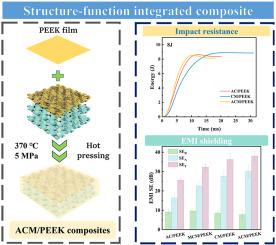Synergistic EMI shielding and impact resistance in nano-engineered aramid/carbon-PEEK composites via gradient architecture design
IF 9.8
1区 材料科学
Q1 MATERIALS SCIENCE, COMPOSITES
引用次数: 0
Abstract
To address the inherent trade-off between electromagnetic interference (EMI) shielding and impact resistance, this study proposes a hierarchical dual-scale decoupling strategy. (1) Macro-scale spatial decoupling: Asymmetric distribution of aramid fibers (AFs) for the impact-resistant layer and carbon fibers for the EMI shielding layer in polyetheretherketone (PEEK) matrix, (2) Micro-scale EMI decoupling: Dual-layer CF architecture comprising MXene/PEI-CB interfacial engineered absorption layer (top) and MXene modified high-conductivity reflection substrate (bottom). Specifically, the strategy synergizes with AF surface modification via PI/CNT-COOH/ANF sizing and the construction of the MXene/PEI-CB and MXene conductive network on the CF surface. This design effectively separates the low-conductivity impact-resistant layer (AF) from the high-conductivity shielding layer (CF) in space, thereby eliminating the concentration conflict associated with interface modification. As a result, compared to the CM/PEEK composite, the asymmetric gradient design (ACM/PEEK) leads to a 26.9 % increase in the absorption coefficient (A), with the overall shielding effectiveness reaching 38.04 dB. Simultaneously, the nano-engineered interface, in conjunction with the intrinsic toughness of AF, effectively dissipates impact stress. Under an 8 J impact load, the peak load increases by 102.25 %, and the damage area is significantly reduced. This study successfully overcomes the traditional trade-off between mechanical robustness and EMI shielding performance. It offers a novel paradigm for the development of lightweight, structure-function integrated electromagnetic protection materials suitable for extreme service environment.

通过梯度结构设计的纳米工程芳纶/碳- peek复合材料的协同电磁干扰屏蔽和抗冲击性能
为了解决电磁干扰(EMI)屏蔽和抗冲击之间的内在权衡,本研究提出了一种分层双尺度解耦策略。(1)宏观空间解耦:聚醚醚酮(PEEK)基体中抗冲击层的芳纶纤维(AFs)和电磁干扰屏蔽层的碳纤维的不对称分布;(2)微尺度电磁干扰解耦:双层CF结构,包括MXene/PEI-CB界面工程吸收层(上)和MXene改性高导电性反射衬底(下)。具体而言,该策略通过PI/CNT-COOH/ANF上浆以及在CF表面构建MXene/PEI-CB和MXene导电网络来协同AF表面改性。该设计在空间上有效地分离了低电导率的抗冲击层(AF)和高电导率的屏蔽层(CF),从而消除了界面修饰带来的浓度冲突。结果表明,与CM/PEEK复合材料相比,非对称梯度设计(ACM/PEEK)使吸收系数(a)提高了26.9%,总体屏蔽效果达到38.04 dB。同时,纳米工程界面与AF的固有韧性相结合,有效地消除了冲击应力。在8 J冲击载荷作用下,峰值载荷增加102.25%,损伤面积明显减小。这项研究成功地克服了传统的机械稳健性和电磁干扰屏蔽性能之间的权衡。它为开发适用于极端使用环境的轻量化、结构功能一体化电磁防护材料提供了新的范例。
本文章由计算机程序翻译,如有差异,请以英文原文为准。
求助全文
约1分钟内获得全文
求助全文
来源期刊

Composites Science and Technology
工程技术-材料科学:复合
CiteScore
16.20
自引率
9.90%
发文量
611
审稿时长
33 days
期刊介绍:
Composites Science and Technology publishes refereed original articles on the fundamental and applied science of engineering composites. The focus of this journal is on polymeric matrix composites with reinforcements/fillers ranging from nano- to macro-scale. CSTE encourages manuscripts reporting unique, innovative contributions to the physics, chemistry, materials science and applied mechanics aspects of advanced composites.
Besides traditional fiber reinforced composites, novel composites with significant potential for engineering applications are encouraged.
 求助内容:
求助内容: 应助结果提醒方式:
应助结果提醒方式:


